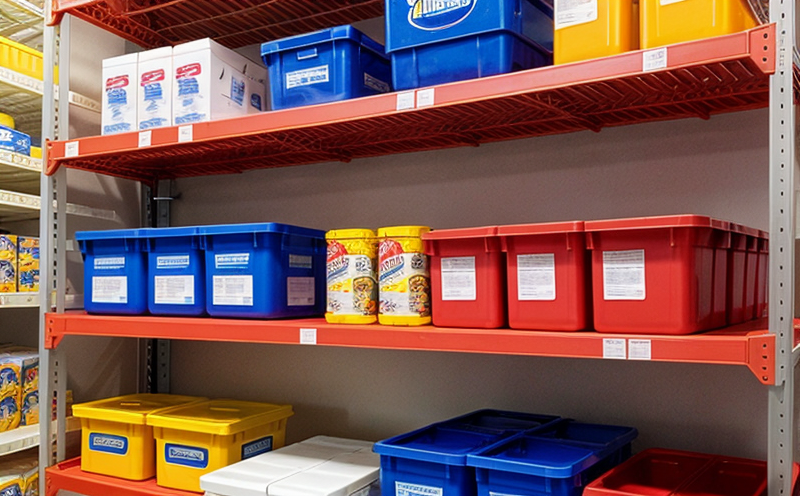ISO 35309 Shelf Life Evaluation in Plant-Based Foods
The ISO 35309 standard provides a comprehensive approach to evaluating the shelf life of plant-based foods. This method is crucial for ensuring product quality and safety while maintaining consumer confidence. For quality managers, compliance officers, R&D engineers, and procurement teams within food and feed industries, this service offers critical insights into how best to interpret and implement ISO 35309 standards.
Shelf life evaluation in plant-based foods involves assessing the stability of products over time under various environmental conditions. The primary goal is to determine the optimal storage duration that ensures product quality, safety, and consumer satisfaction. This process requires a deep understanding of both the chemical composition and physical properties of the food matrix.
The ISO 35309 standard outlines specific procedures for conducting shelf life evaluations using accelerated aging tests. These tests simulate real-world conditions to predict how long a product can remain stable without compromising its sensory, nutritional, or safety attributes. By following this standardized protocol, laboratories like ours provide accurate and reliable data that help manufacturers make informed decisions regarding storage practices.
One key aspect of ISO 35309 involves monitoring changes in the food matrix over time through regular sampling and analysis. This includes measuring physical parameters such as color change, texture modifications, and sensory attributes like taste and aroma. Additionally, chemical analyses focus on identifying potential degradation products that could indicate spoilage or loss of nutritional value.
Another important consideration is microbial growth control during storage. Microorganisms play a significant role in determining shelf life by causing spoilage or introducing pathogens into the product. Therefore, monitoring bacterial counts and other relevant indicators throughout the testing period helps ensure food safety compliance with regulatory requirements such as those set forth by FDA (Food and Drug Administration) and EU regulations.
Proper specimen preparation is essential for obtaining meaningful results from ISO 35309 tests. Specimens should be representative of the final packaged product, meaning they must mimic the actual packaging material used during commercial production processes. This ensures that any observed changes reflect true conditions experienced by consumers rather than artificial laboratory settings.
Instrumentation plays a vital role in executing these evaluations accurately and consistently across multiple batches or samples. Modern analytical techniques such as spectroscopy, chromatography, and microbiological assays provide precise measurements of key parameters throughout the testing process. Our state-of-the-art facilities incorporate advanced equipment to support all stages of shelf life assessment according to ISO 35309 guidelines.
The resulting reports generated from these evaluations serve multiple purposes including supporting product labeling claims regarding shelf life, guiding adjustments to packaging designs, and informing marketing strategies aimed at extending brand loyalty among discerning consumers. Accurate information about the expected duration of freshness can also enhance supply chain efficiency by optimizing inventory management practices.
Scope and Methodology
| Parameter | Description |
|---|---|
| Test Conditions | The standard specifies temperature ranges (e.g., 40°C, 55°C) at which samples are stored to accelerate potential degradation processes. Duration varies depending on the specific food item being evaluated. |
| Sampling Schedule | Regular intervals throughout the test period allow for capturing changes in key quality attributes like color, texture, and sensory properties. |
| Microbial Analysis | Microbial growth is monitored using quantitative methods to ensure compliance with safety standards set by regulatory bodies. |
The evaluation process begins with selecting appropriate test conditions based on the nature of the plant-based food being studied. For instance, more perishable items may require higher temperatures compared to those with longer shelf lives. Once these parameters are established, samples are prepared according to standard procedures and stored under controlled environments.
A critical component of this evaluation lies in regular sampling at designated intervals throughout the testing period. This allows for continuous observation of changes occurring within the food matrix over time. By analyzing physical characteristics such as color development or texture alterations alongside chemical markers indicative of spoilage, we can accurately gauge remaining shelf life.
Microbial analysis plays a pivotal role in ensuring food safety during storage. Quantitative methods are employed to track bacterial populations and other relevant indicators throughout the testing period. These results help determine whether current storage practices meet regulatory requirements established by organizations such as FDA or EU directives.
Customer Impact and Satisfaction
The implementation of ISO 35309 shelf life evaluation directly impacts several aspects of customer experience within the food industry. For quality managers, accurate determination of shelf life ensures that products meet specified duration claims on labels, thereby enhancing consumer trust and satisfaction.
Compliance officers benefit from having reliable data supporting regulatory requirements related to food safety and quality standards. This reduces potential risks associated with non-compliance penalties while fostering a positive reputation among stakeholders.
R&D engineers gain valuable insights into optimizing formulation components or packaging materials that extend product stability without compromising sensory qualities. Such knowledge contributes significantly towards developing innovative solutions aimed at improving overall product performance.
For procurement teams, knowing the precise shelf life allows for efficient inventory management practices such as rotating stock based on age rather than arbitrary dates. This approach minimizes waste by ensuring older products are used first while maintaining fresh supplies available for sale.
International Acceptance and Recognition
ISO 35309 has gained widespread acceptance across numerous countries due to its robust framework for evaluating shelf life in plant-based foods. Many international standards organizations recognize this method as a best practice when determining optimal storage durations.
A number of regulatory bodies worldwide have adopted ISO 35309 guidelines into their respective food safety regulations, including the FDA (United States), EU directives, and various national standards authorities. This global recognition underscores the importance placed on accurate shelf life evaluation within the industry.
The adoption of this standard also facilitates trade between nations by providing a common language for discussing product attributes such as shelf life. As more countries incorporate these guidelines into their regulatory frameworks, it becomes easier for exporters and importers to align expectations regarding quality standards.





